6 Essential Resources for Implementing the Pyramid Model
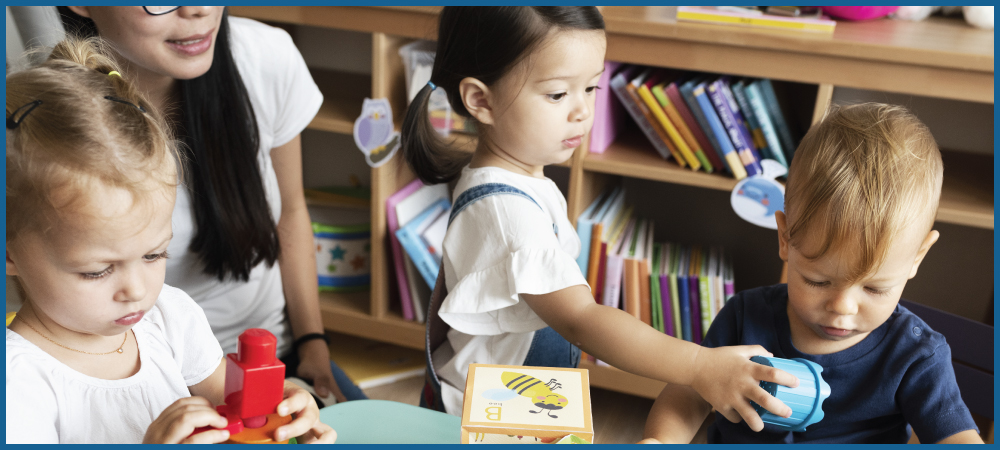
Young children who develop a solid foundation of social-emotional skills are more likely to achieve positive outcomes, both inside and outside of school. For more than a decade, the widely used Pyramid Model for Promoting Social Emotional Competence in Infants and Young Children has been helping early educators boost those key social‐emotional skills in young learners. A framework of evidence-based practices, the Pyramid Model was created to help programs like yours strengthen the social-emotional development of all children, with more intensive, tiered supports for children who are at risk for delays and/or engage in persistent challenging behaviors.
In this article, we’re highlighting six resources—books, tools, and learning modules—that give you the strategies, guidance, and training you need to implement the Pyramid Model successfully. Use these essential resources to help nurture the social-emotional competence of young children, reduce behavioral challenges, and get all children ready for school success.
Brookes is committed to connecting more educators with Pyramid Model practices—and as part of that commitment, we’ve partnered with The Pyramid Model Consortium (PMC), the leading nonprofit dedicated to promoting high-fidelity use of the Pyramid Model. Brookes and PMC are combining their knowledge and experience to expand access to the Pyramid Model’s evidence-based practices and distribute resources and training to educators across the country.
Unpacking the Pyramid Model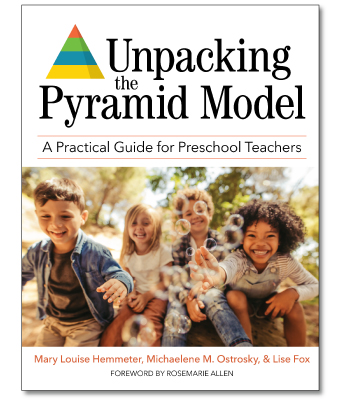
A Practical Guide for Preschool Teachers
Edited by Mary Louise Hemmeter, Ph.D., Michaelene M. Ostrosky, Ph.D., Lise K. Fox, Ph.D.
What it is:
The first book to provide a comprehensive, step‐by‐step overview of the Pyramid Model for children ages 2–5.
Why you need it:
Every preschool teacher knows how important social-emotional development is, but the challenge is how to implement strategies that really work in inclusive classrooms that are already busy.
This book is the practical guide you need to start using the Pyramid Model in your daily routines to promote social-emotional competence. And because the book was written by the expert developers of the Pyramid Model, you can be confident that these strategies will make a positive difference in your program.
Selected topics covered:
- Constructing a positive classroom environment that supports access and engagement for all students
- Developing predictable schedules and routines that maximize participation and learning
- Clearly defining and teaching behavior expectations and rules
- Delivering intentional, explicit instruction in social‐emotional competence
- Supporting smooth transitions that prevent challenging behavior
- Actively teaching young children important friendship skills
- Teaching children about emotions
- Giving children the skills to solve interpersonal problems appropriately
- Providing individualized support for children with persistent challenging behavior
Rave review:
“A clear and comprehensive roadmap for implementing the Pyramid Model. Hemmeter, Ostrosky, and Fox and an all-star cast have distilled a wide array of research-based Pyramid practices into a guide that will be helpful for brand-new teachers and veteran early educators alike. Every teacher of young children should have this book and learn from the experts.”—Judith Carta, Ph.D., Senior Scientist and Professor, Juniper Gardens Children’s Project, University of Kansas
Learn More
- Download this excerpt to preview the introduction and first chapter of the book.
Prevent-Teach-Reinforce for Young Children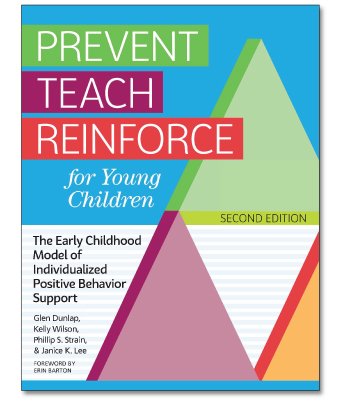
The Early Childhood Model of Individualized Positive Behavior Support, Second Edition
By Glen Dunlap, Ph.D., Kelly Wilson, M.A., ECC, Phillip S. Strain, Ph.D., Janice K. Lee, Ph.D.
What it is:
The second edition of the definitive guide to Prevent‐Teach‐Reinforce for Young Children (PTR‐YC), the premier Tier 3 Pyramid Model intervention that helps resolve persistent challenging behaviors in preschool settings.
Why you need it:
This updated volume was informed by feedback from readers, the authors’ training experiences, and recently published research, so you know you’re getting current and reliable wisdom on effective implementation of the PTR-YC model. Important new additions to this reader-friendly guide include a new chapter on classroom-wide procedures that help prevent challenging behavior, a new chapter on interim solutions to extreme challenging behavior, and downloadable companion materials: checklists, rating scales, case examples, and more.
Selected topics covered:
- Implementing all five steps of the PTR‐YC model, from teaming and goal setting to using assessment data
- Using classroom‐wide procedures that help prevent challenging behavior
- Choosing interim solutions to extreme challenging behavior
- Demonstrating the effectiveness of PTR‐YC (supported by data from a recent randomized controlled trial and single case experimental analyses)
- Ensuring fidelity and sustainability, increasing the chances for long‐term positive outcomes
Rave review:
“PTR-YC, Second Edition, is a great resource for program staff who work with young children to develop social-emotional competencies and minimize problem behavior. Grounded in behavioral science, positive practices, and educational research, this PTR-YC manual provides a comprehensive and easy-to-read guide to design high-quality learning environments for all children.”—Renee Miner, M.Ed., Associate Director, Behavior, Autism, and Low Incidence Disabilities, Center for School and Community Partnerships, Boise State University
Learn More
- Watch this recorded webinar presented by co-authors Glen Dunlap and Janice K. Lee to get a complete introduction to the PTR-YC model.
Prevent-Teach-Reinforce for Families
A Model of Individualized Positive Behavior Support for Home and Community
By Glen Dunlap, Ph.D., Phillip S. Strain, Ph.D., Janice K. Lee, Ph.D., Jaclyn D. Joseph, Ph.D., BCBA-D, Christopher Vatland, Ph.D., Lise K. Fox, Ph.D.
What it is:
An accessible guide to the Prevent-Teach-Reinforce for Families (PTR-F) model, which helps families prevent behavior problems in children ages 2–10, teach proactive communication and social skills, and reinforce positive behavior.
Why you need it:
Challenging or disruptive behaviors that show up in early childhood classrooms are often first seen in a child’s home environment, so it’s essential to have a book that adapts the PTR model for use with parents and caregivers. This is the well-organized guidebook you need to recognize each family’s unique needs and expertly guide them through the five-step PTR-F process. This proactive method of behavioral support will help you increase the number of positive interactions between parents and children, boost healthy social-emotional development, and remedy challenging behaviors before they reach the classroom.
Selected topics covered:
- Establishing a partnership with a family
- Working together to set individualized goals and develop a vision for the child’s future
- Guiding the family through functional behavioral assessment (FBA) to uncover the triggers behind the child’s behavior
- Using results of the FBA to help the family build a customized behavior support plan
- Coaching the family to implement the behavior support plan with fidelity
- Reviewing behavioral data with the family to monitor how well the plan is being implemented
Rave review:
“The authors have synthesized features of a PBS approach into a highly practical, family-centered and family-friendly model that is deeply respectful to children and families, firmly grounded in evidence-based practice, carefully illustrated with case studies, and imminently doable by practitioners in family support agencies. Professionals who aim to empower families to improve child behavior and development in family life will find this book an invaluable aid.”—Joseph Lucyshyn, Associate Professor, Department of Educational and Counseling, Psychology and Special Education, University of British Columbia
Learn More
- Get acquainted with Prevent-Teach-Reinforce for Families by reading this exclusive excerpt from chapter two, How to Work With Families.
ePyramid Module Packages
By the Pyramid Model Consortium
What they are:
Convenient online modules featuring high-quality, evidence-based instruction on the Pyramid Model. Choose from packages focused on infants & toddlers, preschoolers, and birth to five, plus special-topic modules.
Why you need them:
Training your staff in the Pyramid Model is easier than ever with these online modules, which make up a comprehensive training program on all three tiers of the Pyramid Model: universal, targeted, and individualized supports. These eModules are cost-effective, available online 24/7 for the length of your subscription, and filled with real-world videos and examples that show your staff exactly what the Pyramid Model looks like in action.
Topics covered:
- Building relationships and creating supportive environments
- Developing responsive routines and using targeted strategies
- Determining the meaning of behavior and individualized intervention
- Using culturally responsive practices to reduce implicit bias, disproportionality, suspension and expulsion
- Implementing trauma-informed care within the Pyramid Model
- Practicing wellness and self-care techniques
Learn More
- View this video to get an introduction to the ePyramid modules in less than three minutes.
Teaching Pyramid Observation Tool for Preschool Classrooms (TPOT™), Research Edition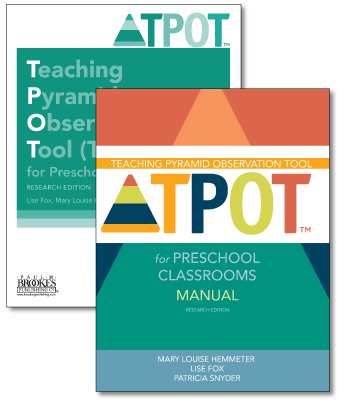
By Lise K. Fox, Ph.D., Mary Louise Hemmeter, Ph.D., Patricia Snyder, Ph.D.
What it is:
A reliable tool developed by Pyramid Model creators that gauges how effectively your staff is implementing 14 key Pyramid Model practices in preschool classrooms.
Why you need it:
The efficacy of the Pyramid Model depends on consistent application of the framework’s three tiers of practices. With TPOT, you’ll have a detailed portrait of which Pyramid Model teaching practices are being skillfully implemented by your staff and which areas would benefit from further professional development.
Benefits:
TPOT helps programs:
- Support implementation of research-proven Pyramid Model practices
- Promote healthy, age-appropriate social-emotional growth in young children
- Implement strategies to prevent and address challenging behavior
- Compare implementation across classrooms, teachers, and programs
- Pinpoint where staff members need additional professional development and support
- Guide training and coaching efforts
Rave review:
“How rare, and how welcome, to find an observation tool that is both user-friendly and research-based! In combination with the Pyramid Model, thoughtful use of the TPOT will help create environments in which all children can be happier and more engaged in learning.”—Marilou Hyson, Consultant, Early Childhood Development and Education; Adjunct Professor, University of Pennsylvania Graduate School of Education
Learn More
- Check out this excerpt to see sample completed pages from the TPOT form, items from the Key Practices and Red Flags subscales, and more.
Teaching Pyramid Infant–Toddler Observation Scale (TPITOS™) for Infant–Toddler Classrooms, Research Edition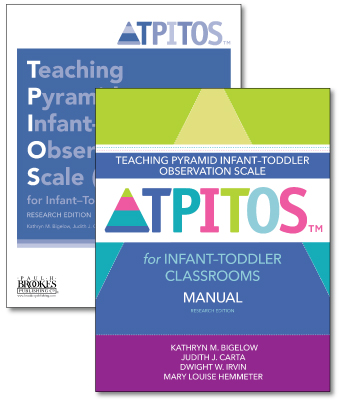
By Kathryn M. Bigelow, Ph.D., Judith J. Carta, Ph.D., Dwight W. Irvin, Ph.D., Mary Louise Hemmeter, Ph.D.
What it is:
Based on the TPOT for preschool classrooms, TPITOS evaluates how well your infant-toddler program has integrated Pyramid Model practices, and supports meaningful professional development for educators as they work toward mastery of those practices.
Why you need it:
A child’s early caregivers and teachers are critical influences on their social-emotional development in the years from birth to age three. By helping to ensure effective Pyramid Model implementation in center-based infant and toddler programs, TPITOS lays the groundwork for a warm, adaptive learning environment that helps foster positive behavior and school readiness in a child’s earliest years.
Benefits:
- Supports professional development efforts in center-based infant–toddler settings
- Helps strengthen the practices of individual teachers or caregivers, classroom teams, and entire programs
- Monitors the success of quality improvement initiatives
- Helps build a foundation for social-emotional competence in the critical first years of life
Rave review:
“The TPITOS tool’s focus on relationships, warmth, responsivity, and emotions is wonderful. It will help early childhood programs with infant and toddler classrooms to develop meaningful professional development for teachers to support our youngest children’s social emotional development.”—Elizabeth Steed, Ph.D., University of Colorado Denver; co-developer of Preschool-Wide Evaluation Tool™ (PreSET™)
Learn More
- Learn about the benefits of TPITOS in this informative Q&A with co-developer Kathryn Bigelow.
With the six resources highlighted in today’s post, your early childhood program can make the most of the Pyramid Model. Together, these books and tools give you the knowledge and strategies you need to help every young child develop the strong social-emotional foundation they need for future success.
Originally Published February 2022

